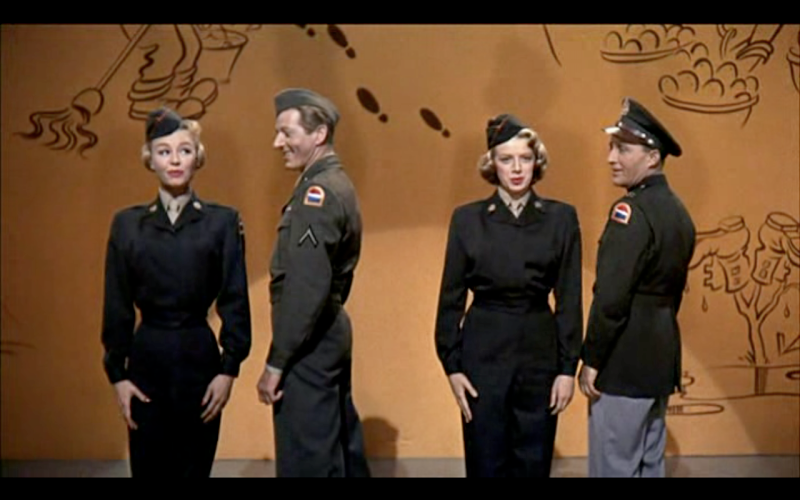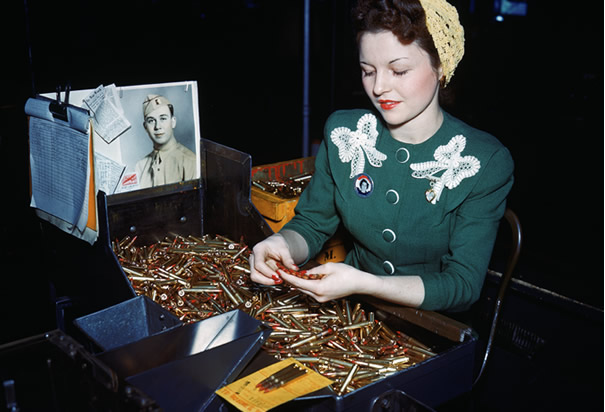Definition: W.A.C. stands for Women's Army Corps, or you may see it as W.A.A.C, the Women's Army Auxillary Corps, as it was often known in 1942.
I'm not going to lie. I haven't always known what a W.A.C. was. In fact, my first exposure to the term itself came from watching Irving Berlin's White Christmas as a young child (Thanks Mom!).
In the first act of the final show for General Waverly, Bing Crosby, Danny Kaye, Rosemary Clooney and Vera Ellen performed a song called "Gee, I Wish I Was Back In the Army Now," in which my favorite stanza was:
"Gee, I wish I was back in the army
The army was the place to find romance
Soldiers and WAC’s the WAC’s who dressed in slacks
Dancing cheek to cheek and pants to pants"
This was my first exposure to the term "W.A.C." Did I understand what it meant? Absolutely not. Did it sound awesome, like perhaps there was some group of women out there randomly whacking people upside the head, or socking them in the arm when they got out line (my kind of ladies)? Heck yes! Did I find out what it was? You betcha!
It was pretty easy to infer that it had something to do with women wearing pants in the Army, and as a girly tomboy (yes I know that's a misnomer), I was all for it. As an young adult, I knew women had served in the military and worked in factories during WWII and been forced back behind the stove in many cases when the boys returned home from war. In fact, one of my favorite iconic images has always been the best marketing campaign ever (or some would argue propaganda) Rosie the Riveter, who encouraged women to step-up, become independent and confident, and take the demanding roles their fellas left behind in the wake of entering the war.
Really, reflecting on it now, this is probably the period when I became completely enamored with historical costuming and pop-culture from the 20's, 30's, 40's and 50's.(We'll cover me re-creating these period looks in a different post)
During the age of Nirvana and Soundgarden, in the midst of a budding Seattle music scene, which I enjoyed like any normal teenager (well ok, I was never a Nirvana fan....don't spread that around too much or the flannel mafia might come a-knocking), I can distinctly remember closing the blinds in my mother's family room during the summer days of high school, locked in with classic 1940's movies on the American Movie Classics channel. (What can I say? I was also reading Shakespeare in the 6th grade, listening to The Doors, Gershwin, Steve Miller Band, Tommy Dorsey, Benny Goodman and The Eagles at age 12. I never claimed I was normal!)
My favorite classic movie of the time? So Proudly We Hail (1943), starring Claudette Colbert, Paulette Goddard and Veronica Lake. (Wowzers) - The story of Army nurses, serving overseas during WWII. Amazing movie. Check it out. (If you delve into the effect of Veronica Lake's hairstyle on factory workers prior to this movie, you'll also see the effect that Hollywood had on a public very much looking for glitz and glamour during an otherwise dismal and dark period of history, even back then. Sound a little familiar?)
Trailer:
This led to reading books on the subject, watching more movies from the time period, immersing myself even more in the music and eventually, many years later, long nights of internet searches and asking for first hand accounts from those I knew who lived it. So by now, you must be asking:
How did the Women's Army Corps come to be?:
While Congress refused to sign into law the original bill that offered women the chance serve as equals and to receive the same benefits as their male counterparts in the Army during WWII, including fighting overseas, "the final bill represented a compromise between the two sides. The Women's Army Auxiliary Corps (WAAC) was established to work with the Army, "for the purpose of making available to the national defense the knowledge, skill, and special training of the women of the nation." The Army would provide up to 150,000 "auxiliaries" with food, uniforms, living quarters, pay, and medical care. Women officers would not be allowed to command men" (Bellafaire, J., 2005).
It is interesting to note that in 1946 the Army ASKED Congress to allow the W.A.C. to become an official part of the Army. Congress took 2 years to do it, but added the W.A.C to its official Army roster in 1948. Interestingly enough, it was still in operation as a separate Army unit until 1978 when it was assimilated into the Army's traditional ranks. Also, anyone who has done a little research into sexual politics during the 1950's knows that, while social movements such as the Rockabilly music scene sought to continue to liberate and encourage independent women, the mainstream, socially driven post-war standard of women's behavior and gender roles turned into what could be considered an attempt to dumb down and un-emancipate those who had showed their independence during the war, when it was absolutely essential for the survival of the country and the war effort. Just a little food for thought there.
So what were W.A.C.s (members of the Women's Army Corps) allowed to do?
They were employed in communications, cartography (map making), running motor pools, as typists, pilots, switchboard operators, secretaries, cryptologists, radiographers, translators, and more, all in addition to the nurses already serving.
All of today's research started with a link that a Facebook page I subscribe to posted on their wall. It was from a blogpost entitled Women at War: WWII (click the hyperlink to go there).
...inspectors, guerillas, film-makers, made propaganda, or performed military and police training alongside men...in the 1940'S!
Teachers, librarians, homemakers, dressmakers, nurses, young adults, the elderly....they're all there, serving their countries and their moral convictions in a time where those resistant to change accused them of questionable character, morals and sexual deviancy, if indeed it could be called that today, for stepping into formerly "Boys Only" boots, though they were also told it was their patriotic duty to do so! And don't forget, they were called unpatriotic if they weren't pretty while they were doing "man's work" too! (I don't look this coiffed and polished NOW and I work at a desk job!!! These gals (above and below) are inspecting BULLETS for goodness sakes.)
There is also an incredible photo of part of the first contingent of African American W.A.C.s sent overseas, a HUGE step forward in civil rights. I must learn more!
And to all those who think women don't have the tenacity (I.E. "GUTS") to be brave during combat, check out these stats.:
For more info on this topic or the time period please see my Research Pathfinder on American Women in WWII located here:
https://sites.google.com/site/thewomenofworldwarii/
Resources: (too tired to pull out my APA reference style tonight...may update at a later date)
http://www.history.army.mil/brochures/WAC/WAC.HTM
http://en.wikipedia.org/wiki/So_Proudly_We_Hail!
http://thefrogseyebrows.blogspot.com/2009/12/cinema-tuesdays-white-christmas.html
http://archive.ccm.edu/rosie/index.htm
http://www.rosietheriveter.org/
http://womenslens.blogspot.com/2011/09/women-at-war-wwii.html
http://www.heresatissueclan.com/viewtopic.php?f=21&t=6997
http://beautyqueensheen.wordpress.com/tag/wwii/
http://www.city-data.com/forum/history/1186414-industrial-innovators-builders-wwii.html
http://cruelkev2.blogspot.com/2009/07/wwii-women-pilots-to-receive-medals.html








No comments:
Post a Comment